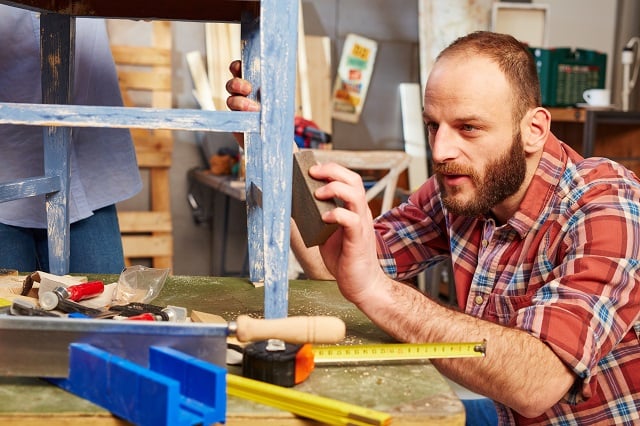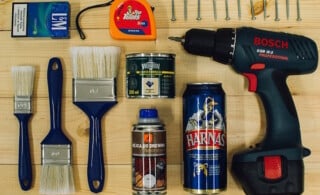
Anyone with a little hands-on experience around the home can spend time tinkering and even repairing items. While some projects might be best left to professional handyman services, there are plenty of things that a novice can do as well. From fixing appliances to remodeling to even auto repair, tinkering can save money and provide valuable opportunities for learning. Even projects that don’t turn out as intended can be a learning experience.
Tinkering
Tinkering is a hands-on form of open-ended exploration to learn about how things work, how to improve them, and how to build new things. Having an area of the home devoted to tinkering can make it more likely that family will spend time exploring and creating.
A tinkering area should have a horizontal work space, adequate lighting, and storage to hold equipment and supplies that can be used for tinkering projects, such as hand tools, electrical tape, batteries, rubber bands, straws, craft sticks, paper, card stock, and more.
An outdoor tinkering lab is also an option for those who enjoy tinkering. An outdoor lab would be perfect for messy or more involved projects that need extra room. A tinkerer might make a homemade battery, a thermometer, a light, or some other object that can entertain or serve a purpose.
- Square Wheels: This tinkering project involves making a homemade vehicle with square wheels to explore movement and motion.
- Make a Battery With Spare Change: With some pennies and a few other household items, you can make a battery to power LED bulbs.
- Build a DIY Thermocam: Making a thermocam at home may seem like a challenging project, but the entire process shouldn’t cost more than $100.
Simple Electronics
Simple electronics projects can be fascinating for someone interested in tinkering and learning. One task that many of these projects involve is soldering electronic components. Components may need to be soldered onto circuit boards to make sturdy connections.
To learn about electronics, a beginning tinkerer might engage in some simple reverse-engineering projects. Reverse engineering involves disassembling gadgets and objects to see how they operate.
- Getting Started With Arduino: A Beginner’s Guide: Anyone interested in exploring tinkering with simple electronics will want to explore Arduino, which is an electronics prototyping platform.
- Build Your Ultimate Electronics Workstation: An electronics workstation can be put together using household items such as a desk, chair, magnifier light, peg board, and bins for storage.
- Reverse Engineering of an Electronics Circuit Board: Taking apart an electronics circuit board is an ideal way to see how the components fit together and work.
- What Is Inside an Alarm Clock Radio? (video): Follow along as an alarm clock is disassembled.
Simple Machines
Simple machines are devices that perform work with a motion or force. Simple machines include levers, wheels and axles, pulleys, inclined planes, wedges, and screws. A few examples of simple machines that people commonly use and have in or around their homes include an ax, a hammer, screws, and even glass jars with threaded lids that screw on.
A tinkerer can use or make simple machines during exploration or while working on projects.
- Lever: Making a lever is a simple project that can involve basic supplies such as a ruler, a binder clip, and objects to add weight. A lever works as a tool to help lift and move objects.
- Wheel and Axle: Together, wheels and axles make it easier to move heavy things. This simple machine includes a wheel, which is a large cylinder, and an axle, which is a small cylinder.
- Pulley: A pulley is a simple machine with a grooved wheel and a rope or chain that makes it easier to lift an object or reverse the direction of a pulling force. By changing the length of the rope or chain in the pulley, it’s possible to increase or decrease the amount of force needed.
- Inclined Plane: Because an inclined plane does not move to perform its work, it may be the most simple of all of the simple machines. An inclined plane sits immobile and is used to move an object from a lower to higher height. A ramp is an example of an inclined plane.
- Wedge: A wedge is actually two inclined planes that are joined together to make a sharp point. The sharp point of the wedge is forced into an object. A nail is an example of a wedge, forced into two or more objects to hold them together.
- Screw: A screw is a simple machine consisting of an inclined plane that is wrapped around a cylinder. Upon applying rotational force to the screw with a screwdriver, the screw pulls and holds objects together.
Engineering
Engineering involves the use of scientific and mathematical knowledge to solve problems or make processes easier. For example, harnessing solar energy to power devices can achieve several goals. The energy from the sun is powerful and cost-effective, and using it to power a device gets the work done in an efficient and inexpensive manner.
Designing and building tools or contraptions that perform work will often involve the use of one or more simple machines.
- Rocket Launch: This activity involves designing a launch device that will propel a model rocket into the air.
- Berry Organic Solar Energy: The dye from berries can be an ingredient in organic solar cells used to change light energy into electrical energy.
- Engineering Challenges (PDF): The challenges included in this activity packet feature hands-on engineering projects such as building an unsinkable boat and a bionic arm.
Coding
Just as tinkering can apply to hands-on work with simple machines and engineering, it can also apply to exploration and experimentation with technology and computers. Tinkering with technology gives people an opportunity to learn, reason, experiment, and try new things.
Coding involves programming languages that are used to communicate with computers. Knowing how to code can open doors that lead to creativity and ingenuity.
- What Is Tinkering? (PDF): People of all ages can tinker with technology to learn coding skills.
- Computational Thinking and Tinkering: Exploration of an Early Childhood Robotics Curriculum (PDF): STEM learning positions children to be able to use technology to further their knowledge in a broad spectrum of subjects.
- Tinkering, Making, and Building in the School Library: Coding is considered to be an integral skill for the 21st century, required knowledge to communicate fluently.
 Snazzy Stuff to Mount on Your Wall Other Than Art
Snazzy Stuff to Mount on Your Wall Other Than Art  Common Small Repair Questions
Common Small Repair Questions  Small Home Repairs: Who Should You Call?
Small Home Repairs: Who Should You Call?  Enhance Home Design with Decorative Leaded Glass
Enhance Home Design with Decorative Leaded Glass  Condo Renovation Considerations to Save Space
Condo Renovation Considerations to Save Space 

Are You Familiar With This Topic? Share Your Experience.